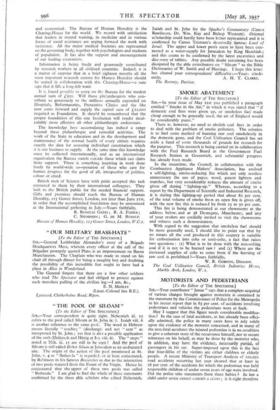MOTORISTS AND PEDESTRIANS [To the Editor of THE SPECTATOR.] Snt,—Your
contributor" Janus" says that a complete acquittal of various charges brought against motorists is contained in the statement by the Commissioner of Police for the Metropolis in his recent report that in 83 per cent, of accidents involving pedestrians and vehicles the. pedestrians were at fault.
May I suggest that this figure needs considerable modifica- tion? In the case of fatal accidents, as has already been offici- ally admitted, the police in many cases have to rely solely upon the evidence of the motorist concerned, and in many of the non-fatal accidents the injured pedestrian is in no condition to give a coherent story of the occurrence himself, nor to secure witnesses on his behalf, as may be done by the motorist who, in addition, may have the evidence, necessarily partial, of passengers in his car. Super-imposed upon this is the fact that four-fifths of the ViCtinis are either children or elderly people. A recent Ministry of Transport Analysis of zoo,00n road accidents occurring last year showed that at least in 28 per cent, of the accidents for which the pedestrian was held responsible children of under seven years of age were involved. Did the police take statements.from these babies ?- .In law a child under seven cannot commit a crime; is it right therefore
that figures relating to infants should be included to weight the figures of responsibility for accidents as between pedestrians and motorists ?
In view of the fact that so many of the victims are children or elderly people, would it not be more to the point if the Com- missioner of Police, in compiling these statistics, investigated, not the question of whose was the original error which led to the accident, but whether the motorist, by exercising reasonable care, could have avoided an accident, despite the error of the victim ? That is a question which is investigated in civil courts when civil liability is under consideration. Did the motorist, who was in charge of the lethal machine, allow a sufficient margin of safety to provide for possible emergencies created by the errors of others, as he is advised to do in the Highway Code ?
That the motorist is not so blameless as the Commissioner's statistics pretend to show is indicated by the fact that there were practically as many accidents between moving vehicles as between vehicles and pedestrians, not to mention accidents between moving vehicles and stationary ones and fixed objects.—







































 Previous page
Previous page